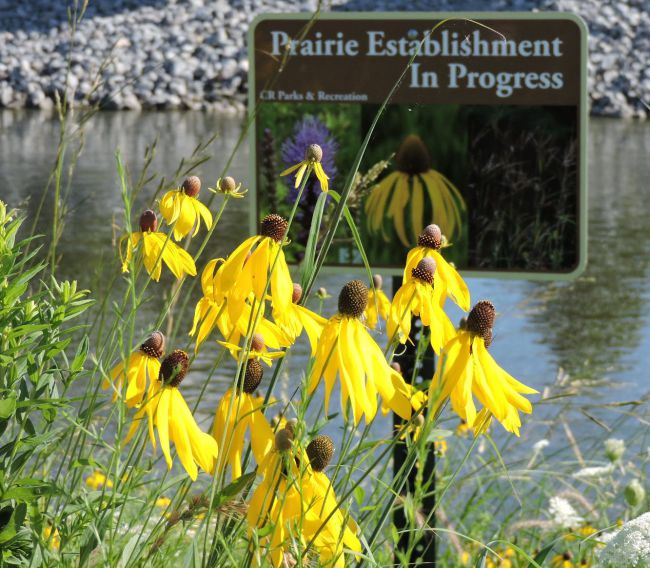According to the U.S. Department of Agriculture, Iowa loses more than 60% of its bee colonies each year. That makes it harder to pollinate plants, fruits, and vegetables, which could drastically affect the state’s agricultural economy.
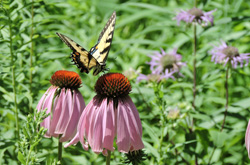 But now, the city of Cedar Rapids says it’s going to do something to stop the numbers from decreasing. Officials with Cedar Rapids Parks and Recreation say they’re setting aside 1,000 acres of land to help restore the pollinator population.
But now, the city of Cedar Rapids says it’s going to do something to stop the numbers from decreasing. Officials with Cedar Rapids Parks and Recreation say they’re setting aside 1,000 acres of land to help restore the pollinator population.
Crews this spring will seed 188 acres with native prairie grasses and wildflowers with the goal of eventually covering a total of 1,000 acres. Parks and Recreation is working with Linn County Conservation and Marion Parks to locate additional unused land.
“They help everything seed and fruit so whether it’s the foods we eat, the foods that many animals eat, pollinators are critical for the reproduction of plants and that goes through seeds and fruits,” says Cedar Rapids Park Superintendent Daniel Gibbins. “With the agricultural boom around 100 years ago, about 99.9 percent of all the native habitat of Iowa has been lost. When you convert it back to what was originally native Iowa, you’re going to help a lot more than just native pollinators. You’re helping birds, amphibians, reptiles, mammals—everything that’s native here relies on native vegetation.”
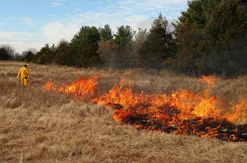 “When creating pollinator gardens, the most important thing is to have a big diversity of wildflowers and heirloom crops that bloom in the spring, summer, and fall,” says Stephen Buchmann, a pollination ecologist at the University of Arizona and author of The Reason for Flowers.
“When creating pollinator gardens, the most important thing is to have a big diversity of wildflowers and heirloom crops that bloom in the spring, summer, and fall,” says Stephen Buchmann, a pollination ecologist at the University of Arizona and author of The Reason for Flowers.
“People think they’ll just plant the wildflowers and the bees will come. And that’s true in some cases, but the smaller the bee is, the less far it can fly. Some can only fly a few hundred meters.”
Cedar Rapids is hoping the new 1,000 Acre Pollinator Initiative will help turn the tide by converting unused public land into prairie. The city is identifying not only parcels of land in its parks for the project but also sections of public sewer and water detention basins and right of ways.
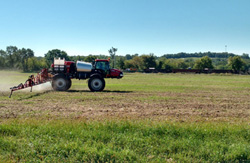 The city’s Monarch Research Project identified the potential of using urban public land to increase pollinator habitat. They approached the City with a request for a commitment to convert unused public land into prairie and initiated a partnership that has become the 1,000 Acre Pollinator Initiative.
The city’s Monarch Research Project identified the potential of using urban public land to increase pollinator habitat. They approached the City with a request for a commitment to convert unused public land into prairie and initiated a partnership that has become the 1,000 Acre Pollinator Initiative.
Currently, the city maintains approximately 125 acres of prairie within the public park system and right-of-ways. The Parks and Recreation Department worked with City land managers to identify acreage suitable for habitat conversion not only within parks, but also sewer and water detention basins, right-of-ways, property managed by the Utilities Department and Eastern Iowa Airport, and portions of City golf courses.
Over 400 acres have been identified within the City of Cedar Rapids for conversion. The City of Cedar Rapids has partnered with Linn County Conservation and the City of Marion to convert additional acreage to meet the 1000 acre goal.
In 2017, Cedar Rapids began converting 170 acres to native prairie habitat. Prairies will be planted along the Sac & Fox Trail and at Squaw Creek, Beverly, Noelridge, Wilderness Estates, and Seminole Valley parks.
Monarch Research Project volunteers plan to urge private land owners to participate with a goal of converting 10 percent of mowed turf to pollinator habitat each year. The Research Project has also committed to help raise funds for the conversion of park turf to prairie. The estimated costs for 1000 acres is between $1 and $1.5 million dollars.
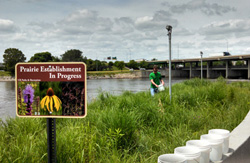 Before Iowa was settled, prairie covered most of the state and central United States. Over 95 percent of tall grass prairies that developed more than 10,000 years ago have slowly disappeared. Prairies provide watershed, water quality, wildlife habitat, pollinator habitat and long term savings through reduced mowing.
Before Iowa was settled, prairie covered most of the state and central United States. Over 95 percent of tall grass prairies that developed more than 10,000 years ago have slowly disappeared. Prairies provide watershed, water quality, wildlife habitat, pollinator habitat and long term savings through reduced mowing.
The Cedar Rapids Parks and Recreation Department has been on the forefront of creating pollinator habitat within an urban park setting. The first prairies were installed more than 10 years ago along the city trail system.
Photo credits: Cedar Rapids Parks and Recreation.
See full Popular Science article by Sarah Fecht.

